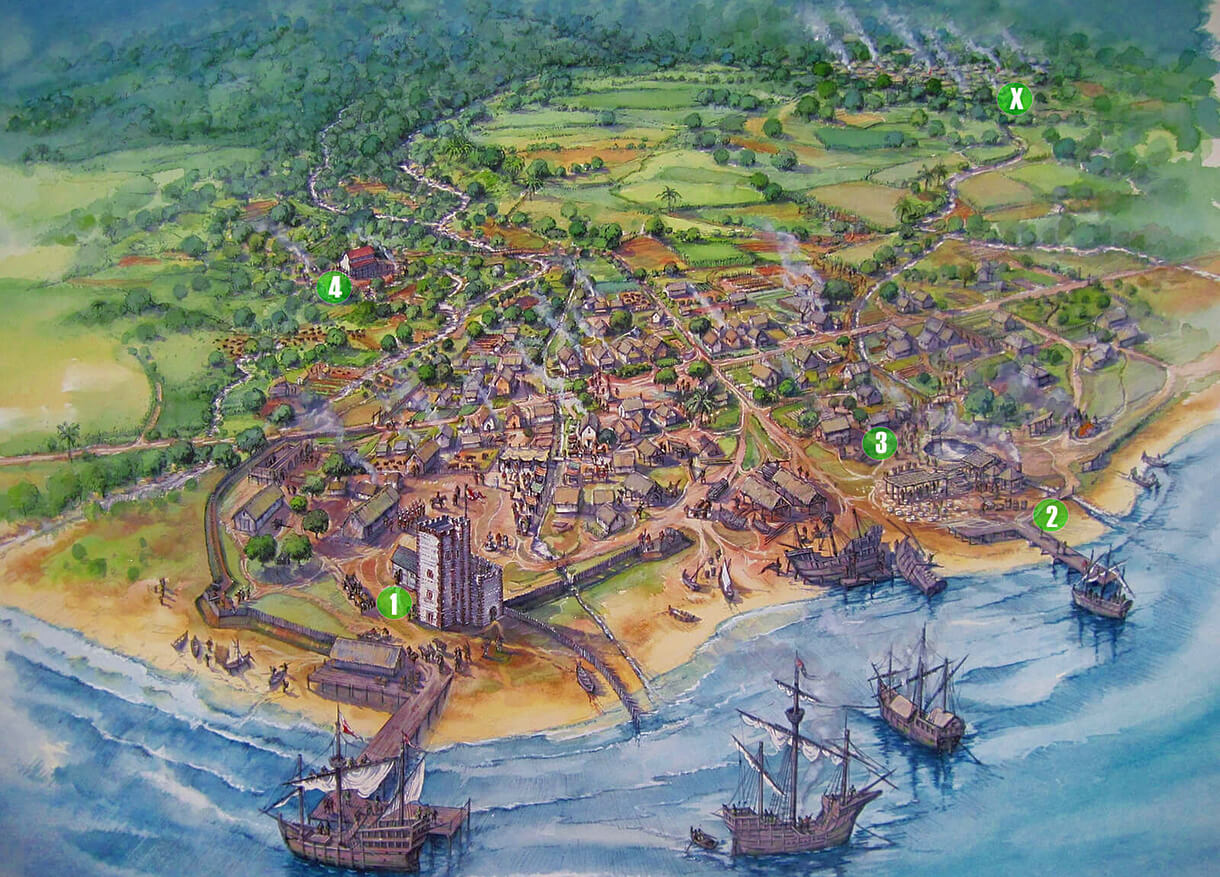The Settlement of the Spanish in Jamaica
Christopher Columbus first sighted Jamaica on May 3rd, 1494 and two days later, on May 5th he went ashore in need of water and wood to repair his ships. He set sail from the island on May 9th and did not return for another 9 years when he and his crew, with two ships already abandoned in Panama and the remaining two no longer seaworthy, barely made it to Jamaica. He landed at the same place he did 9 years earlier and remained shipwrecked on the island for a year waiting to be rescued. During this time, he wrote a letter to the Queen of Spain recounting the voyage, the content of which can be viewed here .
It was not until 1508, two years after the death of Christopher Columbus, that the first Spanish settlers arrived in Jamaica. His son Diego, now named Governor of the Indies, appointed Juan de Esquivel, a conquistador who had been with Columbus on the voyage to Jamaica, as his Lieutenant in Jamaica.
The Spanish Settlers
Esquivel landed at Santa Gloria with 80 citizens and their families to colonize Jamaica. He founded the seat of government near St Ann's Bay close to the Taino Village of Maima. It was called Sevilla la Nueva, later called Sevilla d'Oro (Golden Seville) in anticipation of finding gold. No gold was found, and over time, the Spanish Monarch began losing interest in the island.
The Spanish moved the location of their settlement in 1518, to a location closer to the sea and simplified the name of the new capital to Sevilla. There, the Governor, Francisco de Garay, built himself a castle. By 1525, the town had become a a small colony with a stone fortress, a sugar factory, an artist workshop and a Franciscan monastery, Peter Martyr Church, which was never finished.
Sevilla remained the capital of the island for the next twenty six years until it was moved, for a second time, to what is now known as Spanish Town. At that time, it was called Villa de la Vega, and later renamed to St Jago de la Vega. It remained the capital of the island for the remainder of time under Spanish rule and for many years under the British, who renamed it, Spanish Town.

Reconstruction of Maima and Sevilla la Nueva, c. 1525. courtesy of Peter Dunn, Archaeological Reconstruction Artist
View: North (bottom of screen) to South. The original Spanish colony Sevilla la Nuevo (aka Sevilla d'Oro) was in the Taino Village of Maima (X). It was relocated closer to the sea by the Spanish Governor, Francisco de Garay, around 1518 and the name simplified to Sevilla. He built himself a castle (1) and by 1525, Sevilla was a small colony with a stone fortress, a sugar factory (2), artist workshop (3) and Franciscan monastery (4).
The new Capital of Jamaica
In 1534 the settlers moved the new capital, Villa de la Vega (Town of the Plain), what is now known as Spanish Town. This location was surrounded by good farming land and and it is here that the Spanish introduced the sugar cane; the crop that was to become the engine that drove significant economic boom for the island. This settlement served as the capital of the island for both the Spanish and the English for over three centuries, from its foundation in 1534 until 1872, when the capital was moved to Kingston.
Jamaica evolved in the periphery of the establish Spanish colonies. It existed predominantly as a supply post for the Spanish armies invading mainland America. Ranching, subsistence farming and cattle rearing were the main industries relying on a small slave labor force. Hides were exported and foods were grown to supply the ships that visited, with occasional illegal trading with the Dutch, French and English.
Jamaica remained under Spanish rule for 161 years. Today, the only lasting reminder of that occupation are the names of some places but today, most other reminders of that rule is gone. Settlements established by the Spanish include, Esquivel (now Old Harbour Bay), Oristan (now Bluefields), Savanna-la-Mar, Manterias (now Montego Bay), Las Chorreras (now Ocho Rios), Oracabeza (now Oracabessa), Puerto Santa Maria (now Port Maria), Mellila (now Annotto Bay) and Puerto Anton (now Port Antonio).
The promise of finding gold never materialized and the island remained poor under Spanish rule with relatively very few settlers. Jamaica served mainly as a supply base to support the efforts in conquering the American mainland. Towns were little more than settlements and the lack of attention to the colony led to internal strife that contributed to the weakening of the colony in the last years of Spanish occupation. The governors were not getting proper support from home and quarrels with church authorities undermined their control. Frequent attacks by pirates contributed to the weakening of the colony.
Living in Jamaica was a life of living on the frontier. There were relatively very few settlers and there weren't very many towns. The pockets of existence outside of the new and old capitals were little more than small settlements concentrated mainly on the southern part of the island. It is estimated that the population was about 2,500 in 1655 when the English arrived. There was also a sizable population of slaves. When the British invaded, they encountered a militia force of 1,500 armed Spanish Jamaicans consisting of white, black and colored men. It was a relatively simple task for the 8,000 strong invading force to establish a foothold sufficient enough to wage a prolonged war. It took 5 years for the Spanish to be finally forced from island in April 1660, not because of the strength of the Spanish forces but because Isasi, the governor, received help from Maroons in putting up a fierce guerrilla resistance. The battle was only won when a faction of the Maroons deserted to the English side.
